Dans le domaine du coaching Agile se pose souvent la question de la posture de coach. Dois-je être plutôt en posture basse (questionnement, prise de recul) ou plutôt en posture haute (conseil, solution) ? C’est d’ailleurs un sujet que nous abordons dans ma formation autour de la Responsabilité personnelle.
C’est lorsque Mathilde Russo me propose de collaborer pour répondre à une demande client que je suis intrigué. En effet, ce dernier souhaite « Améliorer la posture de conseil de ses collaborateurs« , ce qui m’apparaît être un thème plutôt intéressant à étudier.
Maintenant, comment répondre de manière pertinente alors que j’ai plus l’habitude de partager autour de la posture basse ? Et bien Challenge accepted ! 🙂
Je vous partagerai ici ce que nous avons proposé lors d’une demi-journée spécifique au thème du conseil avec tout mon cheminement, de la conception au déroulé réél !
C’est parti ! 😉
Contexte
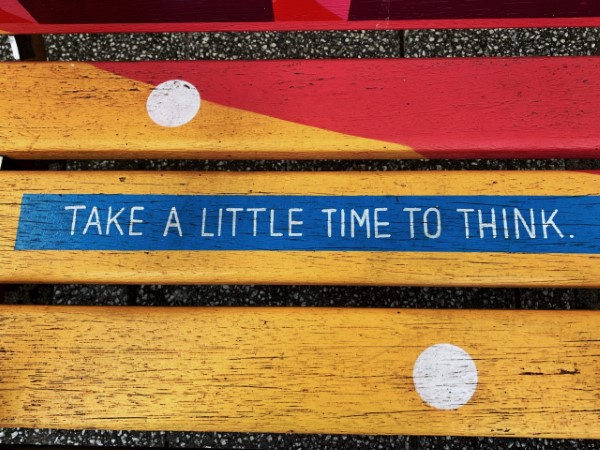
Après un premier échange avec le client pour mieux comprendre le contexte de sa demande, j’obtiens les informations initiales nécessaires à ma réflexion :
- Nombre de personnes : 9 (dont un manager)
- Durée : 3 heures
- Format : Présentiel
- Intention : Rendre ses collaborateurs plus pro-actifs dans leur posture de conseil et améliorer la qualité de leurs réponses vis-à-vis de leurs clients.
Questionnements
Le demandeur semblait vouloir que l’on donne les bonnes pratiques de conseil pour qu’elles soient appliquées par ses collaborateurs. J’ai pour le coup souvent l’impression que cela n’a pas beaucoup d’intérêt, voire même que cela peut être contre-productif :
- En effet, lister des bonnes pratiques sur un sujet flou comme le conseil reste souvent théorique et tend donc à rentrer par une oreille et sortir par l’autre. Je voyais déjà les personnes dire ou penser « c’est évident ce que vous nous dîtes« , « on le sait déjà« . Même si cela ne veut pas pour autant dire qu’elles l’appliquent nous sommes d’accord ! 😛
- Le risque serait de croire qu’il suffit d’appliquer ces règles pour que cela fonctionne. Même si on peut considérer que les grandes lignes sont universelles, il n’en est pas moins vrai que le diable se cache dans les détails. Chaque personne est unique et les relations humaines sont bien plus complexes qu’on pourrait le croire.
Note : Je ne dis pas cependant que cela n’a « aucun » intérêt mais j’ai la conviction que c’est dans la forme que l’on peut maximiser l’impact du contenu. On pourrait donc faire émerger le contenu des participants plutôt que l’inverse, quitte à être moins exhaustif mais plus pertinent.
C’est donc cette direction que je vais explorer.
Note : C’est une manière de m’éviter la confusion autour du terme (que l’on oppose au coaching par exemple). On reste alors sur quelque-chose de concret et d’actionnable pour les participants.
Conception

Comme à mon habitude, je commence dans un premier temps par la contrainte de temps. Nous avons 3h à notre disposition donc en terme de structure, on peut partir sur une introduction (ice-breaker), une conclusion, une pause et potentiellement 2 phases de travail.
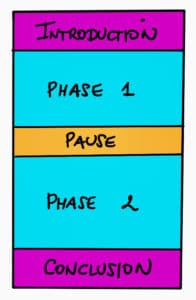
Rentrons donc dans chaque section un peu plus en détails.
Introduction / Icebreaker : Animal Totem

Les personnes ne s’étant pas vues depuis longtemps, Mathilde proposa d’animer un Animal Totem pour briser la glace. Pourquoi pas, l’atelier est rapide, ludique et léger et nous permettrait de démarrer en douceur. L’idée principale est pour chaque personne de définir une combinaison d’un animal et d’un adjectif la représentant.
Note : Un petit peu comme le concept des portraits chinois (« si j’étais un animal, je serai… », « si j’étais un adjectif, je serai… »).
L’important pour moi était surtout de bien avoir une cohérence avec le thème que nous souhaitions aborder. En effet, j’ai à coeur de ne pas faire d’activités pour le simple plaisir de les faire (surtout pour les icebreakers qui n’ont pas toujours très bonne presse) mais parce qu’elles peuvent contribuer à l’objectif final. Il y a donc toujours un débriefing à la clé.
L’idée sera de parler de la connaissance de soi et des autres pour pouvoir ensuite travailler sur la relation. Je réajusterai par rapport à ce qui se passera pendant la session 🙂
Souvenir d'un bon conseil
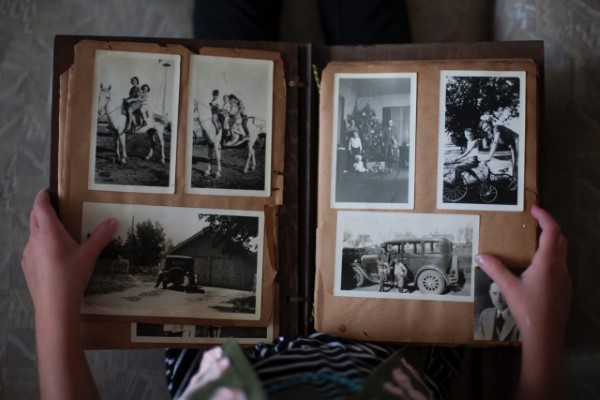
En effet, l’intérêt des histoires et des souvenirs est qu’ils représentent une expérience personnelle intégrale sollicitant les 3 centres d’énergie de la personnalité :
- La tête : par la formulation de l’expérience, permettant de prendre du recul, de faire des cheminements logiques et de structurer les informations
- Le coeur : par le souvenir des émotions tant positives que négatives, spécifiques à la personne
- Le corps : par le souvenir des sensations corporelles liées à l’interaction vécue
Note : Le thème des 3 centres d’énergie est abordé dans les modules gratuits de la formation Manager avec sa Personnalité construite en collaboration avec SuperTilt.
On obtiendrait ainsi des récits spécifiques aux personnes présentes dans le groupe nous permettant de recenser des choses qui sont vraiment importantes pour eux. Les éléments évoqués auront donc potentiellement plus de chances d’être mis en oeuvre par la suite.
- (15′) En partageant leur histoire chacun leur tour avec une personne A qui questionne et note les informations importantes et une personne B qui raconte son histoire
- (5′) De consolider les éléments cohérents des histoires du binôme
- (20′) Puis de les partager au reste du groupe par la suite
Le concept d’animation est donc inversé par rapport à la demande initiale : on partirait d’expériences concrètes et spécifiques pour remonter aux bonnes pratiques plus générales.
Empathy Map
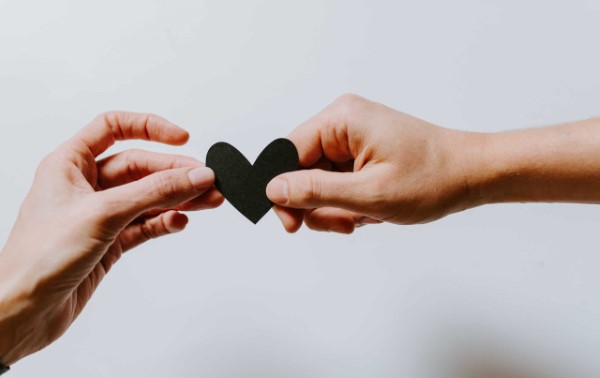
La section précédente était surtout orientée sur la relation entre les 2 parties et sur la façon d’interagir pour obtenir de meilleurs résultats.
Je voulais appuyer sur la dimension de connaissance de l’autre, du client, et ce qui m’est venu à l’esprit fut l’Empathy Map. En effet, non seulement cela apparaît comme un outil supplémentaire (donc rassurant à sa manière) mais c’est à mon avis un excellent support de conversation pour la suite.
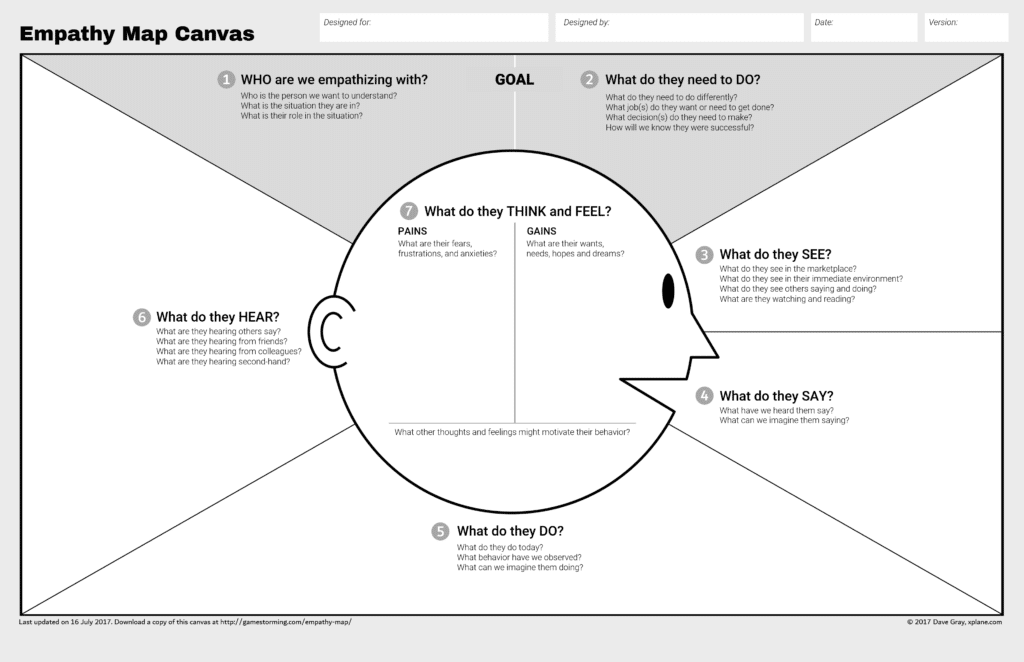
La version pdf peut être retrouvée ici.
Le séquencement serait alors :
- (15′) de faire remplir individuellement chaque personne ce canevas sur un client particulier
- (20′) de présenter son client à une autre personne pour identifier des pistes pour mieux interagir avec lui
- (20′) puis de partager ses apprentissages au reste du groupe
L’idée générale étant de les aider à aller plus loin dans leur connaissance de l’autre en se posant les bonnes questions et en s’ouvrant à une vision extérieure.
Intégration entre pairs

Cette séquence est assez simple en terme d’animation mais me paraît de plus en plus pertinente dans les formations que j’anime.
En effet, c’est un moment où je demande aux participants :
- (15′) d’échanger entre-eux sur ce qu’ils ont retenu, sur ce qui les ont surpris voire même sur les éléments qui ont suscité des réflexions
- (10′) de partager ensuite au reste du groupe l’essentiel de leur conversation.
C’est pour moi une étape clé dans l’intégration du contenu par les participants eux-mêmes sans le biais d’autorité du formateur.
Résumé et Timing
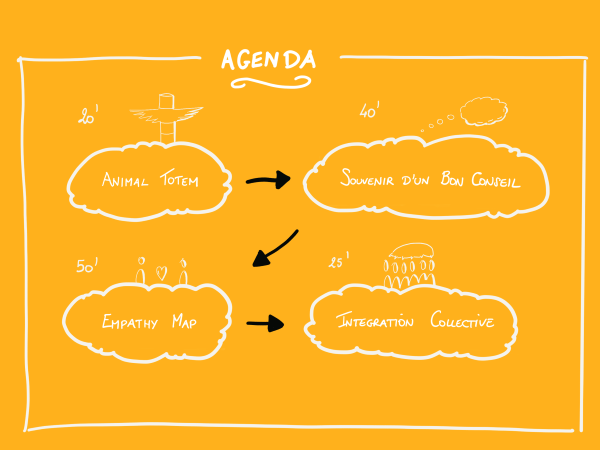
- (20′) Introduction / Icebreaker : Animal Totem
- (40′) Souvenir d’un bon conseil
- (20′) Echange en binôme
- (20′) Partage collectif
- (10′) Pause
- (50′) Empathy Map
- (15′) Travail individuel
- (20′) Échange en binôme
- (10′) Partage collectif
- (25′) Integration entre pairs
- (15′) Réflexion en 3 sous-groupes de 3
- (10′) Partage collectif
- (10′) Conclusion
En conception, on en est donc à 2h35 de contenu pour une durée de 3h prévue. En considérant un retard potentiel au début, les débordements possibles des sections et les temps de latence des transitions, cela me paraît plutôt cohérent.
Je vous propose de voir commence cela s’est rééllement passé à présent ! 😉
Déroulé réel
Animal Totem
Pour cette première partie, je laisse la main à Mathilde qui prend en charge l’animation. Cela me permet d’observer le groupe tranquillement ! 😉
Il existe différentes manières d’animer Animal Totem bien évidemment mais voici celle que Mathilde a choisie :
- Placer les personnes en cercle pour qu’elles puissent toutes se voir les unes les autres
- Demander à chacune d’entre-elle d’inscrire sur un post-it un nom d’animal et un adjectif qui les représentent. C’est bien la combinaison qui nous intéresse.
Note : Bien penser à utiliser des feutres similaires pour éviter de reconnaître trop rapidement les personnes 😛
Note : Certaines personnes ont parfois du mal à trouver un animal donc une piste est de leur demander si un animal les inspire, leur évoque quelque chose de positif. Cela peut les aider à se positionner 😉
Voici quelques exemples qui ont pu émerger du groupe : tigre sauvage, ours polyvalent, taureau réfléchi, chat impulsif…
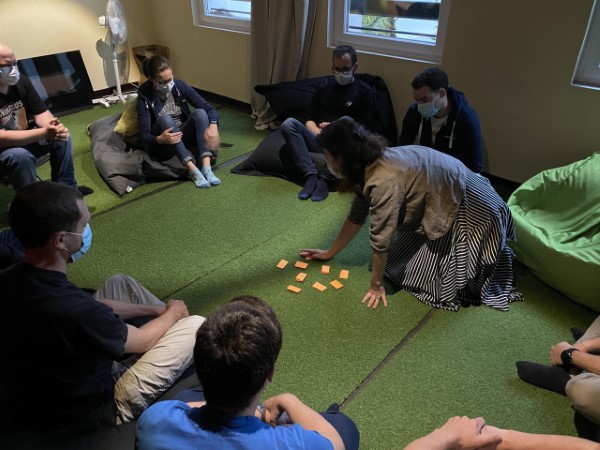
- On plie en 4 les post-its que l’on réunit au centre.
- On les mélange un peu et chaque personne vient piocher un post-it et le garde en main si ce n’est pas le sien. Dans le cas contraire, elle le repose et en pioche un autre.
- Ensuite, chacune à son tour, chaque personne va révéler l’animal totem de sa main à haute voix et donner le post-it à la personne qu’elle pense correspondre. Pas de réaction demandée pour le moment.
Note : Plusieurs post-its peuvent donc être donnés à la même personne. On va juste s’assurer par la suite qu’un seul post-it reste par personne en réattribuant les autres de manière collégiale.
- Lorsque tous les post-its ont été distribués, on passe par chacune des personnes qui vont valider ou invalider l’animal totem qui leur a été attribué.
On peut alors laisser place à quelques échanges et discussions qui vont naturellement émerger 🙂
C’est d’ailleurs ce qui se passe pour ce groupe qui se rend compte qu’ils se connaissent plutôt bien alors que certains d’entre-eux ne sont arrivés que quelques mois plus tôt !
Débriefing
L’ambiance est détendue, Mathilde apporte quelques éléments de débriefing auxquels j’ajoute quelques compléments :
- Apprendre à connaître quelqu’un se fait souvent dans la durée car des patterns se remarquent et nous permettent plus facilement de prévoir leurs comportements (tant positifs que moins positifs).
- Lorsque l’on a une meilleure idée de ce qui est important pour quelqu’un, il est plus facile d’adapter son comportement pour lui apporter son aide le cas échéant.
- Chaque personne est donc différente même si certains grands principes peuvent s’appliquer au plus grand nombre.
- Même si l’on ne connaît pas la personne depuis longtemps, on a toujours un avis. C’est donc dans l’exploration que l’on va valider ou invalider nos hypothèses. Il y a donc un certain effort à fournir pour approfondir la relation.
Souvenir d'un bon conseil
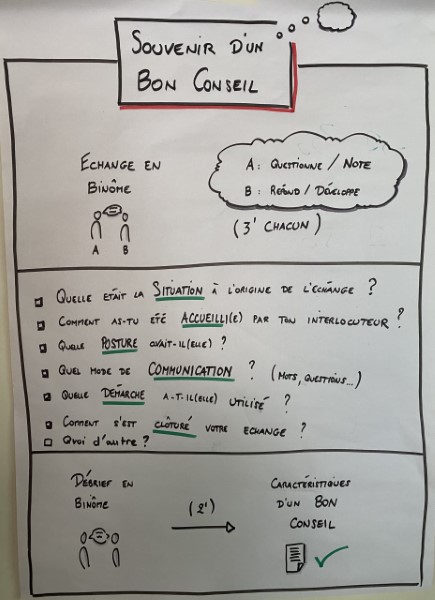
Dans cette partie, je demande alors aux participants de se rappeler d’une expérience dans laquelle ils avaient reçu un bon conseil et d’en discuter à 2. Le binôme me semblait bien indiqué pour permettre un échange plus intime et je l’espère plus authentique.
Pour faciliter le déroulement, j’avais décidé de préparer le petit poster ci-dessus en amont. Y sont décrits le déroulement de la séquence avec la description des rôles mais également un set de questions pour aider à la discussion.
En effet, je me suis dit qu’un petit coup de pouce pouvait être utile pour aller plus loin dans le partage des histoires. J’ai donc proposé des questions de manière à cibler certains critères tels que :
- le contexte ou de la situation à l’origine de la demande d’aide,
- l’accueil proposé par l’interlocuteur,
- sa posture,
- le type de communication utilisé
- la démarche mise en oeuvre pour répondre au besoin,
- la manière dont l’échange s’est clôturé
Et en complément, la question magique du coach : « Quoi d’autre ? » 🙂
Le groupe étant en nombre impair, Mathilde s’est donc mêlée au groupe pour vivre l’expérience de l’intérieur ! 😉
Témoignage de Mathilde
Je me suis donc trouvée en binôme avec l’un des participants. Nous avons trouvé rapidement et facilement un exemple de bon conseil reçu récemment.
Mon binôme s’est lancé en 1er et grâce à la trame d’interview, il fut facile de dérouler son souvenir d’un bon conseil. Ses réponses étaient très précises et j’ai commencé à relever des mots clefs sur des post-it. Les informations données étaient très complètes et riches. J’ai été impressionnée de voir la quantité d’information qu’on pouvait extraire de ce souvenir !
Puis ce fut à mon tour de raconter un bon conseil reçu la veille ! Mon binôme, spontanément, a commencé à compléter et sélectionner des post it que j’avais rédigé en recoupant les informations.
Pour finir nous avons constaté avec étonnement que beaucoup d’éléments de fond nous étaient communs alors que nos expériences étaient très différents à première vue. Nous avons sélectionné uniquement les post-it communs et avons rejoint le groupe.
A la fin du débrief, quand Olivier nous a demandé sur quel axe nous voulions progresser j’ai choisi : « prendre le temps de répondre ».
Ce qui m’a le plus marqué dans les éléments apportés par Olivier : la notion de CHOIX.
Facilitation
Pendant cette phase d’échange entre binôme, je me suis tout d’abord assuré que chaque groupe réussissait à démarrer. En effet, trouver le souvenir n’était pas toujours évident et je leur ai donc proposé de rester simple en prenant une situation dans laquelle ils ont eu besoin d’aide parce qu’ils n’étaient pas en mesure de se débrouiller tout seul (comme par exemple un appel à une hotline pour un problème internet ou EDF…).
Chaque groupe ayant bien démarré, l’observation, l’écoute et le timing furent mes grands points d’attention :
- L’observation pour m’assurer que le binôme était bien concentré et connecté,
- l’écoute non pas pour être indiscret (car le travail en binôme était justement fait pour que la discussion reste entre les 2 personnes concernées) mais principalement pour m’assurer que l’exercice était compris
- et enfin le timing pour garder à l’oeil la structure générale.
Débriefing
Le débriefing en groupe complet fut très riche et malgré 10 histoires personnelles et spécifiques, des patterns communs ont bien émergé.
Voici les éléments qui ont émergé du groupe :
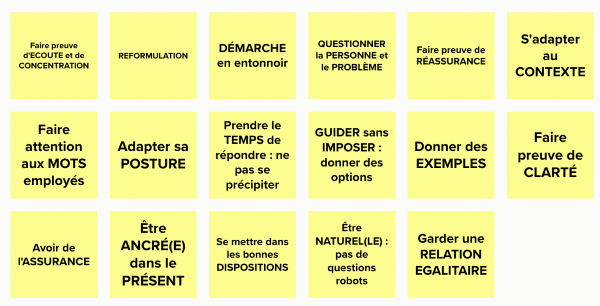
En voyant cette liste, on peut se dire qu’ils ont bien travaillé ! 😉
Maintenant, la liste étant particulièrement longue et ne voulant pas qu’ils prennent peur, j’ai invité chaque personne à sélectionner un des critères de la liste sur lequel elle souhaiterait progresser avant d’enchaîner sur une pause bien méritée ! 🙂
Empathy Map
De retour de la pause, j’introduis cette section en reparlant de ce que nous avons fait auparavant :
- Animal Totem avait pour objet de nous sensibiliser à la véritable connaissance client
- Le souvenir d’un bon conseil était fait pour parler de la relation à l’autre
Nous allons à présent réitérer ces 2 étapes mais sur un cas concret. On commence donc par la connaissance client avec l’Empathy Map.
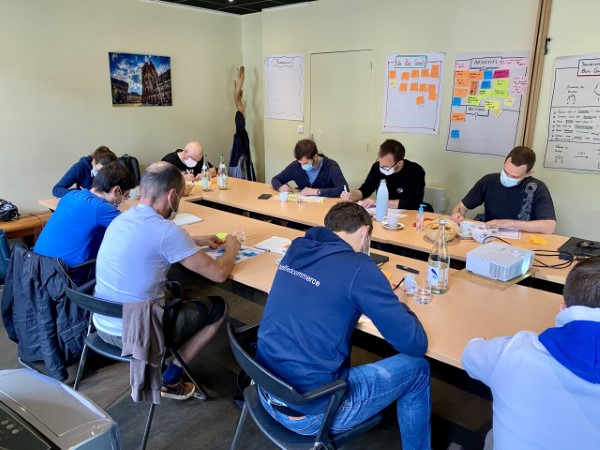
Mathilde ayant préparé des exemplaires A3 imprimés, nous en distribuons un par participant.
Sans tellement plus d’explications, j’invite chaque personne à penser à un client spécifique ou à une personne à étudier et à remplir le canevas.
Note : Il n’y a en réalité pas d’obligation de choisir un client mais vu qu’on y est ! 😛 Certains participants ont sélectionnés des collègues d’autres équipes avec qui ils interagissent parfois par exemple. L’important est simplement d’avoir un sujet d’étude.
Facilitation
Le groupe est studieux et silencieux. Je suis avec attention le remplissage des différents canevas : certains sont plus rapides que d’autres, avec plus ou moins de détails. Je peux sentir que certaines questions amènent plus de difficulté mais la réflexion y est.
À quelques minutes de la fin du temps prévu, les canevas sont globalement à un peu plus de la moitié remplis. Vu que cela me paraît important et que les participants semblent être bien concentrés, je décide de leur laisser une ou 2 minutes de plus pour leur permettre de voir toutes les questions.
Échange en binôme
Après avoir rempli leur canevas, j’invite le groupe à se diviser en binôme et comme pour le souvenir d’un bon conseil de s’isoler pour échanger.
Chaque personne a donc pour tâche de présenter le sujet de son canevas à l’autre et de voir comment il ou elle appréhenderait la relation. C’est une forme déguisée de conseil mais surtout une coopération des 2 parties que l’on cherche à obtenir.
Note : Nous sommes donc bien dans la seconde phase de l’itération contextuelle en travaillant sur une relation plus spécifique.
Facilitation
En terme de facilitation, rien de particulier à signaler car le groupe a déjà vécu ce mode de fonctionnement. Les binômes semblant globalement bien fonctionner, je leur laisse un peu d’air dans leurs échanges.
Je m’attache donc surtout à ce que les groupes démarrent et que les participants pensent à switcher en temps voulu.
Débriefing
Témoignage de Mathilde
Première partie : Empathy Map
Quelle incroyable exercice ! Je me suis prêtée à l’Empathy map avec un peu d’appréhension je dois le dire…toutes ces cases à remplir ça me semblait un peu scolaire au départ.
J’ai choisi de dresser le portrait d’un collègue. Rapidement je me suis rendue compte que certaines cases étaient très faciles à remplir mais d’autres…beaucoup moins !
Première réflexion : je me base sur certains axes uniquement pour appréhender mon collaborateur ! Il me manque des informations pour vraiment le connaître !
Deuxième partie : En binôme, son tour
La 2eme partie de l’atelier me met en duo avec un participant du groupe. Il commence à me présenter son client « cible » et son Empathy map. Je sens bien les frottements et frictions qu’il peut avoir avec cette personne mais je vois aussi que la matrice l’oblige à une certaine objectivité qui change sa perception.
Après l’écoute, je prodigue spontanément ma perception et des conseils à mon binôme. Mes phrases commencent par « Moi ce que je ferai dans ce genre de cas c’est …. » , « ce que j’entends là de cette personne c’est ….« , « as tu essayé cela avec cette personne ?« . Ravie de voir mon binôme, le visage illuminé me dire : « Mais quelle bonne idée ! Je n’ai jamais essayé de faire ainsi« . Et quelle sensation d’accomplissement pour moi d’avoir eu l’impression de prodiguer « un bon conseil ».
Deuxième partie : En binôme, mon tour
Puis vient mon tour de présenter mon collaborateur via la matrice…l’exercice est un peu long, nous supplions Olivier de nous donner plus de temps 😉 Mon binôme, lui même manager, va en quelques minutes à peine, me donner sa vision de mon collègue (qu’il n’a bien sur jamais vu) : c’est fulgurant. Puis il me donne à son tour des pistes de réflexion pour améliorer ma relation avec lui : je suis véritablement bluffée par la justesse de ces conseils que je n’avais pas du tout envisagés moi-même ! Nous revenons avec le groupe un peu abasourdis pour débriefer.
La puissance de l’atelier est incroyable : dès le lendemain j’ai mis EXACTEMENT en application les conseils reçus durant l’atelier et les résultats sont très probants ! Succès total pour moi et que d’apprentissages
Voici en vrac quelques éléments remontés par le groupe lors du partage collectif :
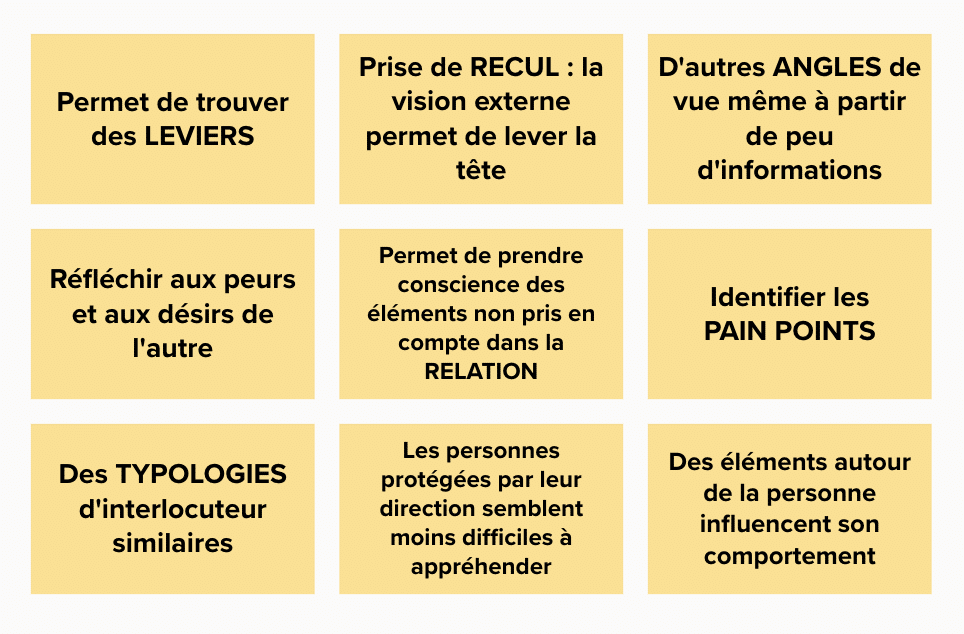
Intégration entre pairs
J’invite ensuite les participants à former des groupes de 3 et d’échanger autour de ce qu’ils retiennent de cette demi-journée.
Voici ce qui en est ressorti :
Animal Totem
On se connaît plutôt bien !
Conseil
Notre cadre de jeu n’existe pas, cela mériterait de faire un workshop à ce sujet.
J’ai identifié des pistes d’amélioration personnelle et collective pour apporter plus de valeur à nos clients. On pourrait reprendre la liste, se focaliser sur 1 point et l’améliorer ! (Qui a dit Agilité ? :-P)
On pourrait proposer plusieurs interlocuteurs aux clients, cela permettrait de travailler sur l’interchangeabilité de notre équipe.
Donner plusieurs options et adapter sa posture au client
La liste fait peur, il faudrait cocher des cases pour se rassurer car il y a bien des choses que l’on fait déjà !
On connaît déjà ces éléments mais dans la mise en oeuvre c’est différent !
Empathy Map
Attention à ne pas donner trop de détails qui amèneraient à de la sur-interprétation. L’idée est de ne pas trop influencer.
Avoir la vision d’une autre personne aide à prendre du recul.
On pourrait le faire sur d’autres profils. C’est un support qui évolue dans le temps.
Pas facile de se mettre à la place de l’autre !
Conclusion

La conception et l’animation de cette demi-journée thématique fut particulièrement enrichissante pour moi. C’est un sujet que je n’aborde finalement que très rarement mais qui semble avoir eu un certain impact.
Plus que des discussions superficielles, j’ai pu sentir une véritable remise en question de certaines personnes sur leurs modes de fonctionnement et une envie de faire mieux pour apporter plus de valeur à leurs clients.
Avec le recul, je pense qu’il est important de ne pas juste répondre à une demande exprimée par un client mais d’apprendre à la remettre en perspective par rapport à ce que l’on sait faire de mieux, avec la ferme intention d’apporter le maximum de valeur.
Les participants semblent avoir été satisfaits, Mathilde et moi également donc cela méritait d’être partagé dans le cas où cela puisse être utile ! 🙂
PS : N’hésitez pas à passer voir ce que Mathilde fait tant que vous y êtes 😉

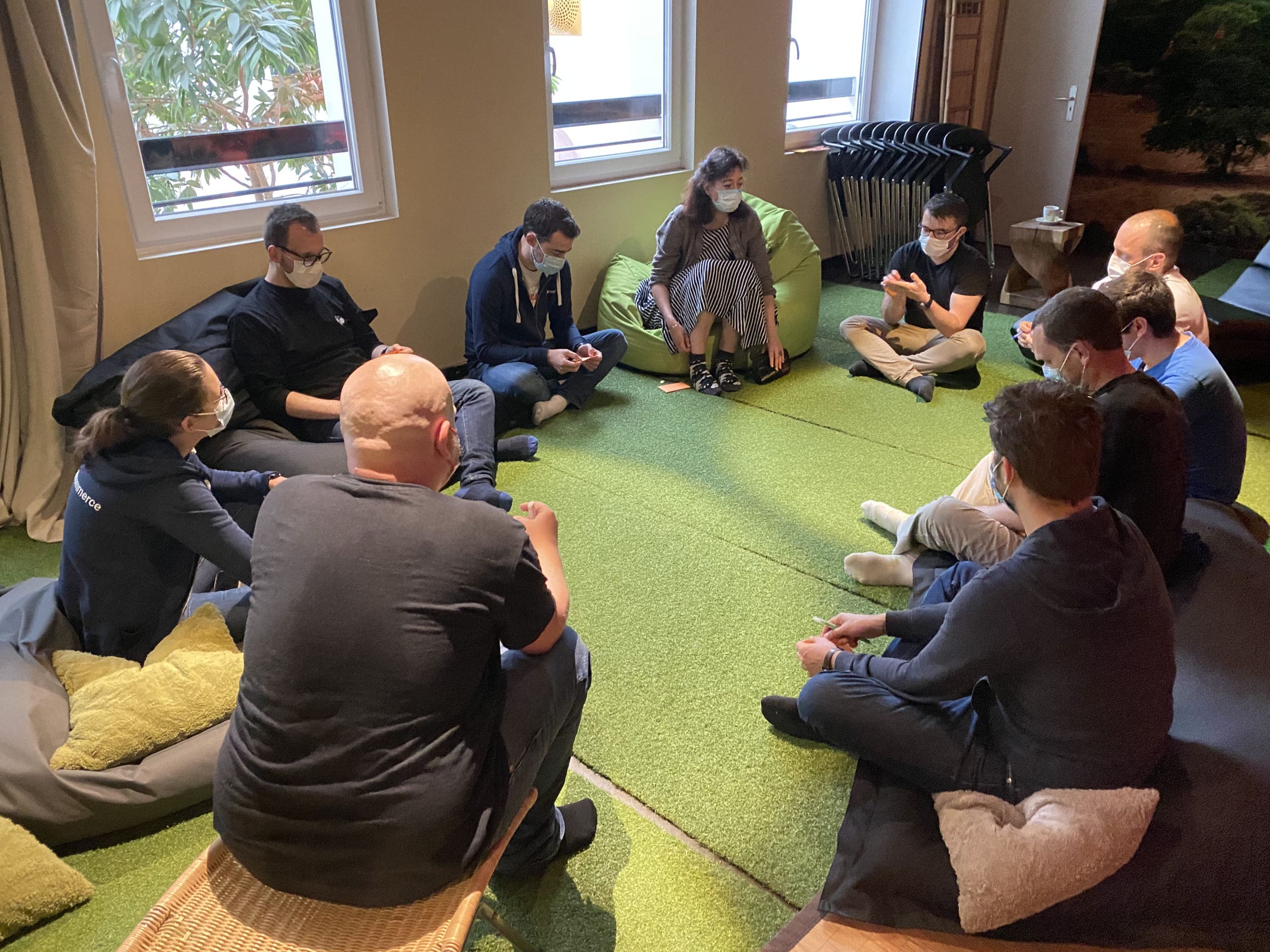






4 réponses
Bonjour Olivier, cet article m’a permis de passer quelques minutes agréables en satisfaisant ma curiosité de découvrir comment vous avez répondu à cette demande initiale. L’article est très clair est détaillé ce qui en a fait pour moi une excellente source de réflexion. Un grand merci pour ce partage.
Bonsoir Pierre,
Merci beaucoup pour votre message !
Cela m’encourage à continuer de produire ce genre de contenus !
Belle soirée à vous.
Olivier
Merci pour cet article !
Super déroulé, et explications tjs très concrètes, c’est top, merci bcp !
Bonsoir Florence,
Merci beaucoup pour ton message 🙂
Belle soirée.
Olivier